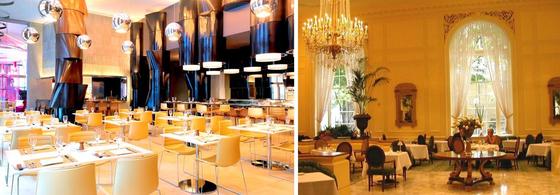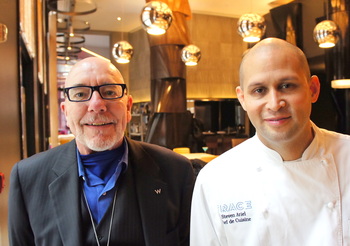
The new style of hotel dining: TRACE's contemporary look (at W Seattle), compared to the baroque Georgian Room (Fairmont Olympic).
TRACE, the W Seattle's new street-level "living room" and restaurant (formerly Earth & Ocean) opened last month after a three-month, $2.5 million remodel. It's the third TRACE restaurant, following similar "re-wondering" of W hotels in Austin, Tex., and San Francisco.
True to its brand as the edgy alternative to the staid Westin, W Seattle combines the elegant with the plebian, both arty and utilitarian. The dining room, bright and airy, features functional, lunchroom-style tables and chairs, but the chairs are covered with a faux-leather gold lamé. It's part of each W Hotel's identity as a "design-led lifestyle brand." The Portland firm of Skylab Architecture came up with the design: Seattle tones of gray and silver, flanked by columns that are both abstract totem poles and waterfront piers.
 The chef de cuisine for the W Seattle's 100-seat restaurant (as well as room service and banquets) is Steven Ariel, a native of Honolulu, who has worked his way around Seattle since 2006: Canlis (executive sous-chef), Cafe Juanita (sous chef), and Luc (chef de cuisine). His hotel experience in Hawaii is standing him in good stead in his new position.
The chef de cuisine for the W Seattle's 100-seat restaurant (as well as room service and banquets) is Steven Ariel, a native of Honolulu, who has worked his way around Seattle since 2006: Canlis (executive sous-chef), Cafe Juanita (sous chef), and Luc (chef de cuisine). His hotel experience in Hawaii is standing him in good stead in his new position.
"It's not traditional fine dining," says W Seattle GM Tom Limberg. "We want to see locals come in every day, not just for special occasions." The menu states TRACE's mission of creating meals from locally sourced ingredients (farmed, foraged, crafted, hunted), from appetizer staples like Dungeness crab cakes and "market greens" to Washington steelhead with trofie pasta. The bar offers locally distilled spirits; the wine list is studded with local treasures like Sparkman Cellars Lumière (chardonnay) DeLille Cellars Doyenne (syrah).
There's a sushi bar along the back wall of the dining room (Seattle roll, $10 along with the usual suspects, salmon, amberjack, octopus, albacore). The bar menu also offers oysters, a pork chop, and short-rib sliders. "Guests love being in the space," Limberg says, "and prospective customers want to hold their meetings and events in the hotel because of the way it looks and feels."
All this comes as the lodging industry re-examines almost every aspect of its business. As a recent article in the New York Times pointed out, the changes are being driven by the expectations of travelers in their 20s and 30s who don't respond to their parents' and grandparents' notion of a hotel lobby as a mahogany-paneled retreat and an overstuffed hotel room as a refuge.
"Interesting is more important than comfort," said industry analyst Bjorn Hanson, who teaches at NYU. Hotel lobbies are getting updated so that younger travelers (in shorts and T-shirts) feel at ease doing email, having a drink and socializing in the common areas rather than in private rooms, a phenomenon industry executives call "isolated togetherness."
Because of the brand recognition of its corporate family (Starwood properties and the worldwide chain of Westin Hotels), the W Seattle is the most prominent player in this lodging category, which, locally, includes the Max, the Monaco, the Alexis and the Hotel 1000.
At the Hotel Max, for example, the restaurant is called Red Fin, and it has a stand-alone sibling, Wasabi Bistro, in Belltown; it serves innovative Asian-fusion fare in an ultra-modern atmosphere. The bar features a variety of Japanese sakes. At BoKA in the Hotel 1000, there's flexible seating in the lobby bar for impromptu groups of two to twenty; there's a "glass bamboo" sculpture by Seattle artist J.P. Canlis.
By contrast, old-line hotels like the Four Seasons specify a "smart casual" dress code and request a reservation. The Georgian Room at the Fairmont Olympic drips with elegance and ornate grandeur: Palladian windows and spectacular chandeliers. But these are staid palaces that appeal to older, more seasoned travelers.
The pioneer of premium hotel dining, decades ago, was Fuller's, in what is now Seattle's largest hotel, the Sheraton (adjacent to the Washington State Convention Center). Fuller's is long gone; nowadays the Sheraton lobby has only a coffee shop ("In Short Order"), and, except for banquets, shuffles its guest meals off to a mid-market steakhouse, The Daily Grill, at the end of a labyrinthine corridor off the lobby.
TRACE in the W Hotel, 1112 4th Avenue, Seattle, 206-264-6060 
Leave a comment